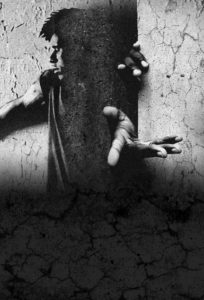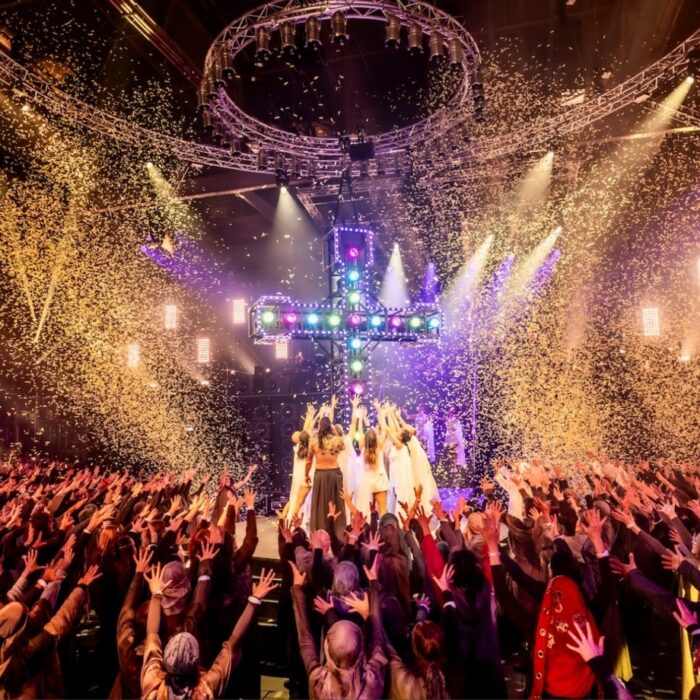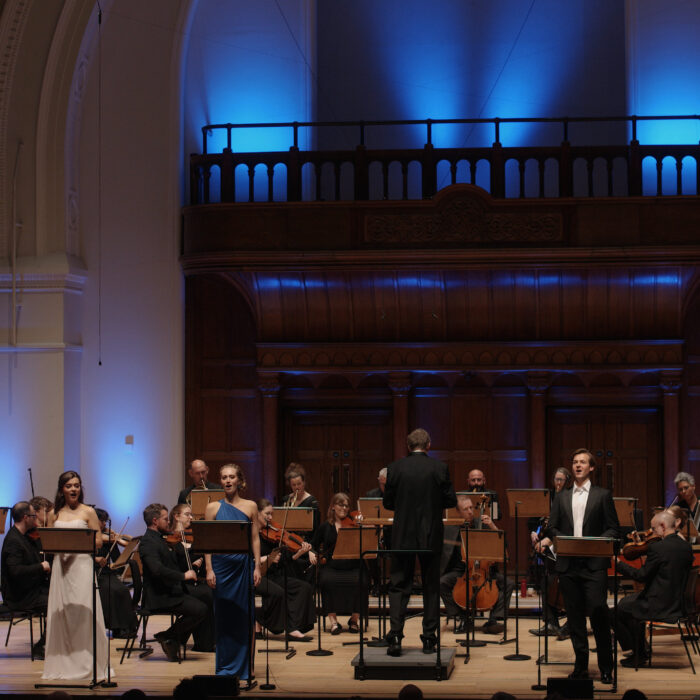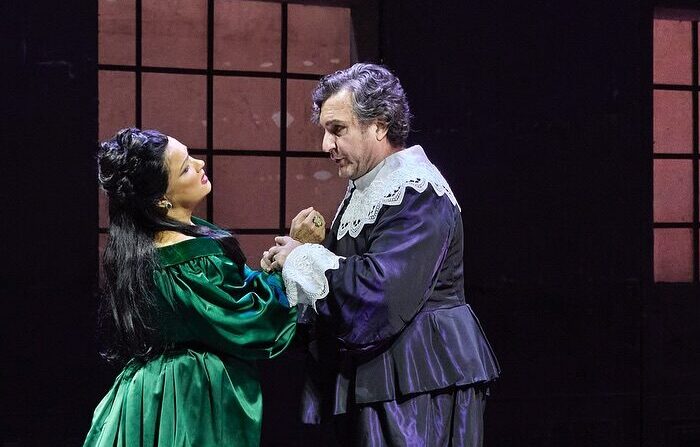
Los Angeles Opera 2021-22 Review: The First Bluebird in the Morning
LA Opera Conjure Up Some Magic With this Solid Digital Short
By John VandevertLA Opera is no stranger to livestreaming. Since the COVID-19 pandemic first shuttered theaters, they have been at the digital forefront, continuing to provide exceptional performances, albeit in new and exciting ways that worked within stipulated health regulations. But even before the pandemic, in 2019, LA Opera’s imaginative production of “The Magic Flute,” directed by Barrie Kosky, used state-of-the-art projection technology to create an Alice-in-Wonderland spectacle.
Since then, the company has swiftly devised and introduced fresh modalities for presenting opera and deepening the relationship between on and off stage experiences. Whether by excluding subtitles to enhance audience engagement in the story, pairing performance with installation art to create immersive events, or illuminating the public on the creative process from original conception to finished product, it’s safe to say that the focus on increasing opera’s accessibility is certainly alive and well in California.
LA Opera’s newest digital short, “The First Bluebird in the Morning,” composed by Carlos Simon with librettist and playwright Sandra Seaton, and choreographed and directed by the esteemed Jamar Roberts, is a testament to the company’s commitment to presenting the art form in new ways. The film stars tenor Joshua Blue and dancer Lloyd Knight.
This star-studded work of multimedia cinematography challenges audiences to think about the meaning of freedom, who longs for it, and how it’s inevitably taken for granted by those who have it. The narrative relates the timely story of an incarcerated Black man who, in his downtime between monotonous chores and daily routines, watches a bluebird and nourishes hope of one day tasting the sweet nectar of freedom. It’s not because he wishes to live excessively, but simply, relishing little things like making bread, doing laundry, dressing himself, and watching the sun rise in the morning.
In Simon’s revealing summarization of the work, he writes, “This piece is a soliloquy of sorts from the perspective of an inmate experiencing life as a prisoner while finding hope and solace in the freedom of a bluebird. I’ve composed dark, brooding music to represent the mundane life of prison, which transforms later into a vibrant dance when the inmate gazes and admires the colorful bird.”
The Series, Creation and the Film’s Narrative
A remarkable part of LA Opera’s innovations has been their focus on further expanding their digital offerings. At the beginning of the pandemic, the company announced its exclusive partnership with the online streaming-service Marquee TV to livestream mainstage and related performances. This set the precedent for LA Opera’s commitment to new approaches to opera. “We plan to continue to feature and commission work from the most in-demand composers and visual artists for more digital shorts,” stated Vice-President of Artistic Planning Rupert Hemmings last year, And continue they have. As of this writing, there are nine richly diverse shorts available for streaming!
Dedicated to changing the standardized modes of operatic performance into what the company calls “a visceral and visual storytelling format,” LA Opera’s Digital Shorts explore contemporary social issues and the breadth of creative possibilities when the operatic art form coalesces with other vehicles of expression. The coalition of mediums into an easily digestible and accessible experience enhances the perception of the music.
While film cannot authentically replicate the physical sensations of music, it can express an intuitive sense of interiority unavailable through in-person experience. Since the multifaceted aspects of opera performance can be overwhelming, streaming video’s start and stop buttons give the viewer a sense of ownership of their experience.
“The First Bluebird in the Morning” is the dynamic creation of a small, seven-member team who came together to produce a piece of audio-visual literature around the theme of mass incarceration and the human experiences behind the skewed rate of imprisonment among the Black population.
As of 2021, nearly 1 in 81 African-Americans are serving time in state prison, and, on average, Blacks are 1.3 times as likely to be sentenced to jail, according to The Sentencing Project. Shockingly, in 12 states across America, Black people account for more than half the state prison population, while in seven states the proportion of Black to White populations is 9-to-1.
Built upon this alarming foundation, Simon and Seaton collaborated on how to best express this devastating reality. The fruit of the collaboration was a four-verse soliloquy presented by the protagonist, an incarcerated young man named Joshua. The narrative follows the undulating, emotional threads of Joshua’s daydreaming in between the tedium of daily-life behind bars.
Filmed in a black and white, with a musical fabric that seems to go every and nowhere, and oscillates between jarring stratification of tenorial tonnage and supple strands of neo-Romantic and Ravel-like creaminess, the film destabilizes our preconditioned understanding of freedom by robbing the viewer of nature itself.
The film’s near meta-autobiographical narrative begins with a panning shot through billowy clouds that open to a gray-hued sky. The palette casts a foreboding aura over the otherwise bucolic blueness. Joshua is quickly introduced, standing alone underneath the canopy of a large tree, and surrounded by vegetation as sunbeams penetrate the rustling flora above.
Although the audience meets Joshua in nature, the real Joshua is locked inside an iron compound for reasons unknown, and perhaps unjust. When LA Opera’s dexterous tenor Joshua Blue awakens his range, it reveals the paradoxical and allegorical phenomenality of this film’s narrative.
After this initial introduction to the dialectic (and perhaps even diegetic) forces at play, the rest of the five-minute film plays out in a series of vignettes. However, each vignette (or self-contained dream) has no beginning, end, or observable identity of its own.
Lloyd Knight, principal dancer at Martha Graham Dance Company, immerses himself in the strife, anguish, and resilient convictions of Joshua in four different ways throughout the film—perhaps following the 12 stages of grief. For me, Nietzsche’s concept of “amor fati” (love of one’s fate) describes this digital short, particularly so when Blue lets out a final impassioned exclamation, and we see Knight silently accepting his destiny.
Music and Libretto as Artistic Synthesis
Describing the short-film’s musical direction, Simon wrote, “I’ve composed dark, brooding music to represent the mundane life of prison, which transforms later into a vibrant dance when the inmate gazes and admires the colorful bird.”
The work’s formal design, a rather precocious tertiary format with a porous introduction and nebulous coda that fades into a supercharged nothingness, underscores his declared sentiments. Joshua’s spirit wrestles with even the thought of eternal monotony that emanates from the gentle ripples of chamber abstractions and soft-hearted cooing, while the work’s main infatuation fills out with irresolute melodicism tinged with the hints of postmodernist vociferations à la Berg, Messiaen, and the Second Viennese School line.
Seaton’s extraordinary libretto semantically explains Simon’s sedate, dreamy sensuousness and looming existentialism interlaced with levels of disquietness typical of Romantic and neo-Romantic idioms. To me, the soundtrack of Joshua’s post-internment hopes throbs with a constantly replenishing, inchoate sense of self-awareness. With additional textural influences of dark jazz, back-room blues, and film noir amour, Simon’s score could be described as hypnagogic (infra)vitalism. Each push and pull of the musical fabric speaks volumes about composer, performer, and listener simultaneously.
As stated by Seaton, much of the libretto’s inspiration came from a combination of the chillingly ubiquitous feelings of COVID-inspired isolationism and the cataclysmic effects of sustained solitude on the human psyche, as well as her initial desires to write a libretto based on the narrative of a young man about to leave behind visible detention [prison] for liberated detention [parole].
The primary vehicle of expression in Seaton’s libretto is a vein of empathetic, yet unidealistic and rather unromantic sense of escapism—the kind which doesn’t seek to transport the believer’s consciousness, but neither wishes to invite active engagement in the immediate surroundings. Seaton notes that “Because the limitations of the space create tension, Joshua is in a constant battle to see if he can handle his small world.” He does this by adopting a relationship with routine that he doesn’t wish to become accustomed to, yet must act out daily for fear of punishment.
As espoused by Seaton herself, the sheer amount of work it took to create the libretto is exemplified through the text’s morphological synergy and relatively strong cohesion of narrative vision from beginning to end. Seaton’s libretto comprises three nearly syllabically identical verses, with a middle episode between the second and third, which, consequentially, fulfills the “Golden Mean” present in temporal-based art.
Further, Seaton’s usage of repetition to denote psychological tedium is brilliant. These observations are vital as the usage of stability and instability are perfect, linguistic realizations of Simon’s quasi-symphonic score, which refuses to rest until the last minute, and even then rest is only the perception of absent audibility.
The last paragraph of Seaton’s notes casts this entire project in a new light, and transforms Simon’s music from a psychological bricolage of musical effects and idioms to a “living” chanson under the volatile umbrella of legato intimacy.
Seaton writes, “I wanted the listener to infer his good qualities through observation, which in turn allows a listener to root for him and his release instead of resenting or doubting the presence of those qualities.” Simon realized the statement using semi-tonal chromaticism and pressurized vocal lines during the second verse. These suddenly break and return to the first verse’s diatonic atmospherics. Blue sang impeccably the third verse, which reads as Joshua’s pertinacious mantra, with seven growingly emphatic iterations of “Come morning” interspersed with the things he’ll do once liberated.
One mustn’t forget that Blue is but the agile invocation of Joshua. Encased within every authoritative lick of flame and sonorous vocalise of Blue’s are Joshua’s feelings of paradoxical motile immobility. The tenor handled the tension of stratospheric leaps and bounds in the upper register exceptionally well, and the prolonged usage of emphatic dynamics and demagogic legato doubles this. With such music, even well-seasoned tenors like Blue need a heightened awareness of technique at all times. Pianist Howard Watkins’ lush, Debussy-like arpeggiations and cellist Anja Wood’s resonant condolences underscore this, and seemed to speak the unpleasant yet necessary truth of Joshua’s situation; it will get worse before it gets better, but don’t dare stop looking for the bluebird.
When Cinema and Choreography Unite
Visibly “hidden” within the short film, whose length fully conceals its imaginative filling, is a novel, dare I say, even Renaissance approach to audio-visual storytelling. Jamar Roberts, director and resident choreographer for the Alvin Ailey Dance Company, handled the cinematic realization of Simon and Seaton’s handiwork using what I’d describe as a visually through-composed format. Few kinesics are repeated, with any repetition used to punctuate cues provided by the music, and underscored by textual orations.
In verse two, the audio-visual atmosphere radically changes to something wholly anagogic and surreal as Sisyphean “etudes” of motion, lacking any teleological drive, visually represents the enforced monotony and lethargic feelings associated with Joshua’s incarceration. Throughout the film, the use of black and white cinematography, optical tricks, and unseen light sources sets a new precedent for instrumental, visual, and oral personification of emotions.
This ability to play with the concepts of humane vs. ruthless, human vs. paradigm, and even sympathetic vs. repulsive, makes “hearing” the film a riveting experience from beginning to end, equal, at least in my reading, to the audience-minded Homeric epic, the caressing ache of a Tchaikovsky-like etude, or any 19th-century art piece styled in the elusive image of Symbolist esotericism.
The reader may think such assertions excessive or imprudent hyperbolism, but as someone who trained as a dancer, I’m enthralled by modern dance’s ability to tap into the brutal eroticism of uncultivated movements and volitional ownership of one’s faculties. The film incorporates several key elements into its body to heighten the choreographic life’s Nijinsky-like vulgarity.
While observationally “easy” in the sense that no excessive amounts of mastery or technical prowess is needed to complete any particular move, one can “feel” Knight’s exercising muscle, heightened heart-rate, warmed breath, and the forming beads of sweat.
It’s this sense of knowing and unknowing that underscores the entire film, and certainly the dance. Because there is no audio of the dancer, we are left to imagine what is and is difficult for the dancer. The strenuousness of the dance moves are not disclosed, leaving us in the dark to only theorize about what Knight might be feeling, as normally we could hear breaths and slaps of the body against surfaces; things that demonstrate a human is moving in front of us. But we are gifted no such luxuries, and the para-social relationship built by a dancer and their audience is not afforded.
I loved how director/choreographer Roberts only exhibited Knight’s face at the beginning, and ended with his back facing the camera, as if removing the thought of singleness from the picture entirely, perhaps making Knight a stand-in for a universal feeling of anomie?
A truly spectacular ‘Libera me’
As the malicious toll of time bangs steadily onwards, all around it, melody, tonality, rhythm, and meter dilapidate quickly under the sheer weight of Joshua’s existential suffering. And yet, amidst the mounting pressure and insurrectionist affections, as Saint Mark chronicling John’s baptism of Jesus Christ wrote, “the heavens broke open, and the Spirit descended upon him like a dove.” Or, in this case, a bluebird.
In Christian symbology, the bluebird represents the embodiment of the continued strength one needs when facing hardships, which seems too strong to handle alone. Joshua outwardly observes a bluebird, and inwardly sees his persevering hopes, desired happiness, and cleansed heart right waiting for him just out of reach from his tiny window.
With fragrant melodicism and bilious harmonies restored, and with the words “my time is up,” Joshua no longer feels hopeless, and instead manifests himself in the freedom he dreams. As the pianistic textures fill out with serene arpeggios and the cello’s timbre re-enters, the tenor’s incessant repetition of “Come morning” grows increasingly desperate until Joshua issues his last word-based dictation, “We’ll fly away.”
While the tenor takes (temporary) flight into Elysium, the cello gingerly floats downwards and melts into the broadened piano arpeggios of an unknowingly paradoxical Ravel-like Impressionism, where the sweet taste of childlike hypnagogia is knowingly laced with the painful understanding of the temporal continuum.
But Joshua’s faith isn’t broken just yet, nor is the bluebird out of sight. As the bluebird sings its dulcet yet sputtering diddy, Joshua hums as if not to let the moment go so fast into that good night. Abiding in the pensive euphoria and the comforting indulgences of directionless harmonies, Joshua walks between aged columns to a destination with no name, wearing an expression that has no face. The sound stops, and visuals end, but not the message.
I highly endorse this digital short and suggest everyone try to watch.


